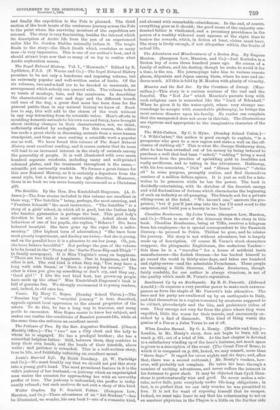promises to be not only a handsome and imposing volume,
but an extremely popular and well-written series of books. Of the six volumes, two-and-a-half are to be devoted to mammals, an arrangement which nobody can quarrel with. The volume before us treats of monkeys, bats, and the carnivores. In describing
the characteristics of cats and dogs and the different breeds and uses of the dog, a great deal more has been done for the general public than in any natural history we know of. Need- less to Bay, this will add to the charm of the work without in any way detracting from its scientific value. Man's efforts in moulding domestic animals to his own use and fancy, have brought about striking changes in their characteristics, not, we think, sufficiently studied by zoologists. For this reason, the editor has made a great stride in discussing animals from a more human standpoint, and thus at once making a scientific work a popular one as well. We have found this volume of The Royal Natural History most excellent reading, and it seems certain that its issue will lead to an increased interest in the study of animals among the generality of people. It is well illustrated with over seven hundred separate woodcuts, including many and well-printed coloured plates, and the treatment throughout is the same,— scientific yet eminently readable. We foresee a great future for this new Natural History, as it is certainly a departure from the usual style, but a departure in the right direction. Moreover, there is no book we can more honestly recommend as a Christmas gift.


















































 Previous page
Previous page